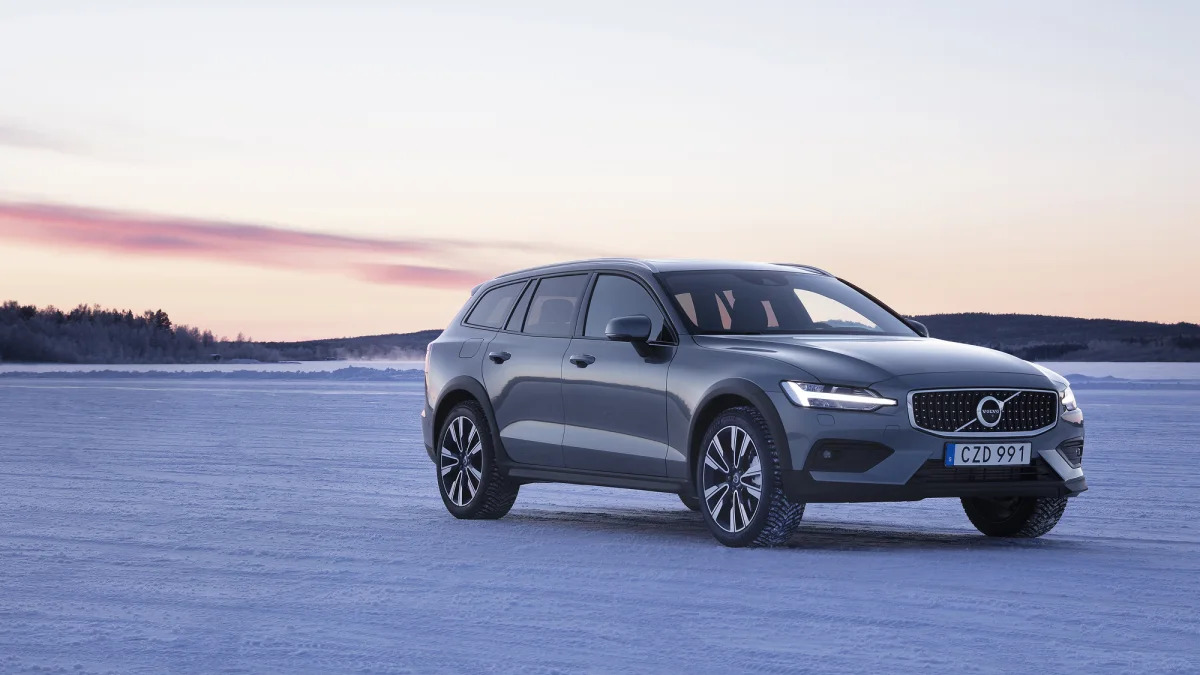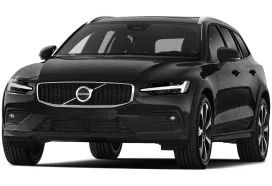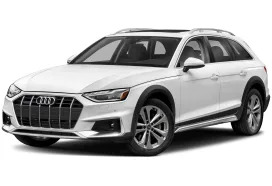-
Engine2.0L Turbo I4
-
Power250 HP / 258 LB-FT
-
Transmission8-Speed Auto
-
0-60 Time6.7 (est.)
-
Top Speed143
-
DrivetrainAWD
-
Curb Weight4,116 LBS
-
Base PriceTBA
LULEÅ, Sweden — The trees are white, and the sky is pink. It turns out the top of our planet looks like a different planet. I'm driving the 2020 Volvo V60 Cross Country near Luleå, Sweden's northernmost habitation fairly called a city. It's 99 miles south of the Arctic circle, 80 miles from Finland, and its name rhymes with Coolio. The temperature reads -13 F, which'll freeze the inside of your nose in seconds, but is actually warmer than it was in Chicago and Detroit the same week.
Despite these literally polar conditions, owning a hardcore vehicle doesn't seem to be necessary. Snow tires sure are, and preferably something studded like the Michelin XI rubber fitted to our Cross Country, but this isn't an Iceland-like moonscape best suited to Land Cruisers. There are front-drive Volkswagens aplenty, old Subarus and, not surprisingly, an abundance of Volvos. Many have three gigantic auxiliary lights bolted in front of their grilles.
You understand why after the pink sun rolls laterally into the horizon. It's dark. Extremely dark, and the in-car clock is only showing 5 p.m. Fitted with bi-LED headlights with automatic high beams, the V60 thankfully doesn't need to besmirch its handsome face with mini Batsignals. The light pouring from its headlights is crisp, white and hopefully noticed by Luleå's local moose and reindeer population. If it isn't, the Cross Country's forward collision warning and automatic braking system detects large animals as well as pedestrians.
Of course, braking, be it automatic or the old-fashioned way, is only so good as the traction under-tire. Those Michelin XI's are shockingly good, sticking resolutely to a mix of ice, snow and a spackling of pavement. Until they don't.
On this rural Swedish highway lined in those white-dusted trees with a 10-yard buffer of snow in between, driving closer to the center just seems like good sense. The optional head-up display is showing speeds fluttering between 20 and 25 mph on a road with an indicated speed limit of about 45 mph. One assumes that's more of a summer thing.
Headlights appear ahead, so I slowly move to the right. The Volkswagen Passat passes, but I can feel the car ever-so-slightly sliding further to the right. I realize the road is icier than it was earlier. Before I can correct in any way, the right front wheel slips off the pavement — what had looked like the snowy edges of the road was in fact a bit of ditch overplowed perfectly flat. Game over.
The view ahead turns bright white, not by some divine passage, but rather those LEDs reflecting off the world's fluffiest white snow blasting forth by the Cross Country. Had someone been standing there with a camera, it would've been majestic. As it is, though, we're undamaged but absolutely stuck and listing 40 degrees to starboard. That ditch worth of fluffy powder managed to stop us (I have to imagine my hard braking did zilch) and there was nothing damaging lurking below.
One can credit Sweden's superior road maintenance, or perhaps the Cross Country's extra 2.4 inches of ground clearance over the regular V60 (also fully redesigned for 2020 and arriving at dealers in July; unlike the V90, it will not be special order only). Of those 2.4 inches, 0.4 come from extra tire sidewall – be it the standard 18-inch wheels or the optional 19s or 20s. Ours buried in the ditch are 19s. Although it was frankly tough to tell given the atypical road conditions and tires, that extra sidewall results in a cushier ride than the firmer set-up in the Cross Country's S60 sedan sibling. Volvo hasn't quite figured out how to reconcile big wheels and ride quality, but as in the V90 Cross Country, the extra rubber and air between wheel and road do make a difference.
So too do the changes made to the suspension itself. It maintains Volvo's standard SPA platform setup of double wishbones up front and distinctive transverse leafs springs at the rear, but the spring rate is 8 percent softer than what's used in S60 and V60. According to Volvo vehicle dynamics engineer Mattias Davidsson, that's a greater softness gap than the one between the V90 and its Cross Country version (their air suspension option is unavailable on V60). He and other engineers solidly reasoned that those seeking a raised, off-roadish wagon would be willing to sacrifice some handling precision for a comfier ride.
Some of that precision may indeed be lost, but it wasn't abandoned entirely. Volvo actually widened the V60's track, contributing to the Cross Country's chunkier, more macho appearance. Changes to the rack-assisted electro-mechanical power steering were also made to ensure that the Cross Country's suspension changes didn't muck up the S/V60's commendably responsive and tactile steering. Putting the steering into its sportiest setting (through either Dynamic or Individual mode) adds a welcome bit of extra weight that's not only beneficial for aggressive driving, but in icy conditions, it lent extra information and therefore confidence. For all the good it did me.
To free the Cross Country from its powdery ditch, the press launch's XC90 safety vehicle affixes a tow strap to the bumper's shipping hook. While its driver slips and slides forward on the road/ice, a second safety driver in the Cross Country guns it into reverse. Looking like a fish being dragged on a line across the rail of a boat, the gray Volvo kind of starts to free itself. Well, the angle has at least changed a bit. And the left rear wheel is spinning up in the air.
The latter is a tell-tale sign that the Cross Country's BorgWarner all-wheel-drive system does not possess the sort of side-to-side torque-vectoring capability of the Buick Regal TourX or Acura's Super-Handling All-Wheel Drive. To be clear, no all-wheel-drive system would've been able to deal with all that powder and ice, but in another scenario, having the ability to proportion power to individual wheels can actually make a difference between freeing yourself or calling for a winch to unceremoniously drag you away. Which is exactly what was eventually needed to get us back under way, the Cross Country seemingly no worse for wear.
The next day, we traded that ditch for the Baltic Sea. This time on purpose. Luleå is situated in an archipelago of sorts, which you can tell by looking at a map or visiting in July. But in January, it is just a town surrounded by a lot of white. The vast plain south of town is in fact an inlet of the Baltic, frozen to a depth of almost 32 inches, which locals use as a seasonal park. We, however, will be using it as a handling course.
Honestly, there's only so much vehicle evaluation that can be conducted in such an environment. You get to see how much the stability control intervenes in full and ESC Sport modes — going through a series of S curves will result in a predictable thunk as the brakes grab in full ESC at every apex, whereas Sport mode will let you slide a bit, play with the throttle and handle things by yourself. Fun!
The other element is the all-wheel-drive system, which is front-biased to prevent oversteer. Rear-biased AWD systems will still let you kick the rear out when driving in slippery conditions and steer more with the throttle, but the Cross Country would only do so if the ice and your steering angle had already coaxed the car into a slide. Understeer is the name of the game, which for a car like this, is exactly as it should be for the vast majority of drivers more interested in sure-footed winter traction.
The engine exclusively paired to that BorgWarner AWD and ZF's trusty eight-speed automatic is Volvo's T5 engine: the turbocharged 2.0-liter four-cylinder that produces 250 horsepower and 258 pound-feet of torque. The turbo- and supercharged T6 and plug-in hybrid T8 engines are not available on the Cross Country. They really aren't missed, as the T5 is a perfectly competitive engine for the segment. The Cross Country's closest competitor, the Audi A4 Allroad, produces 248 hp and 278 lb-ft, while achieving an EPA-estimated 25 mpg combined. That's exactly what the outgoing V60 Cross Country and its similar T5 powertrain achieved. Volvo hasn't released fuel economy data yet (and there's no all-wheel-drive S60 T5 for comparison), but we wouldn't be surprised if the new car managed a bit better.
Its cabin is definitely a lot better, and gives the Allroad a run for its swank money. Like other Volvos, the Cross Country cabin oozes Scandinavian cool. The real woven metal trim that snakes across the dash and covers the sliding center console door looks rich and feels richer. Everything else, from the high-quality plastics, soft leather and vertically oriented Sensus touchscreen, is common to Volvo's 60 and 90 Series cars.
In terms of space, the V60 is considerably larger for 2020. It has nearly 4 extra inches of wheelbase, contributing to 1.7 extra inches of back seat legroom. It's still not exactly sprawl-friendly back there, but it's comparable to an Allroad, and a 6-footer can just fit behind another. Headroom is quite good, even below a panoramic sunroof.
The 2020 V60 Cross Country's overall length is also nearly 6 inches greater than before. That, along with 2 extra inches of cargo area width and a boxier roofline, results in a bigger, more utilitarian wagon than the outgoing model, which was more like a hatchback. In fact, the V60's cargo area has virtually the same length as the XC60 crossover, but it's wider, and that boxier shape above the seatbacks should make it easier to haul bulkier items. Medium-sized dogs should be happier too.
This improvement in cargo space and interior quality makes the 2020 Volvo V60 Cross Country a far more competitive vehicle. And not just in terms of the misfit collection of raised wagons — it's a more attractive alternative to crossovers, too. Volvo marketing reps echoed their Buick counterparts in saying that buyers who actually go outdoorsy places with bikes and kayaks (as opposed to simply being attracted to them by commercials) are far more likely to go for a raised wagon like the Cross Country than an SUV like the XC60. The lower roof height certainly helps, but there's also an element of being different from the norm. "Go your own way" literally and figuratively.
It should also help that the V60 Cross Country is drop-dead gorgeous. The sharp crease of its rear "shoulders"; the tasteful size of its grille and LED signature lighting; the fender flares that appear purposeful rather than tacked-on. The XC60 has similar elements to be sure, but to these eyes, the Cross Country is better proportioned, with a certain cool factor. It's enough to take time to stand back and admire — even if it's minus 25 and you're waiting for the safety car.
Related Video: What Makes a V60 Cross Country a Cross Country

















Sign in to post
Please sign in to leave a comment.
Continue